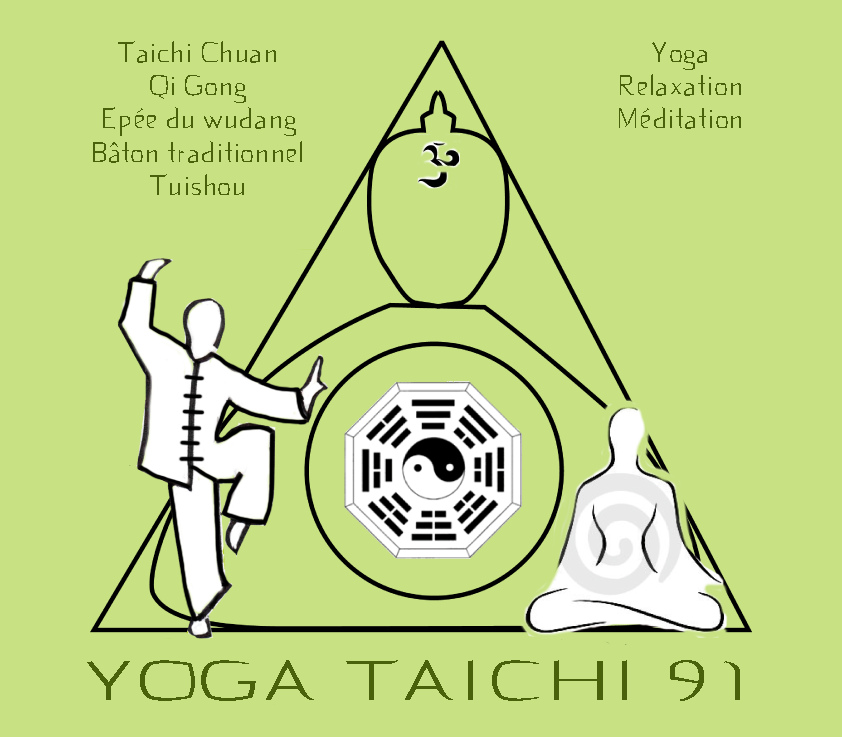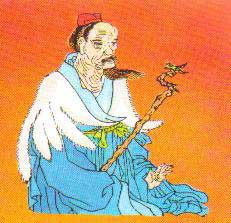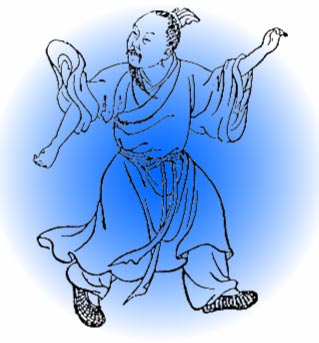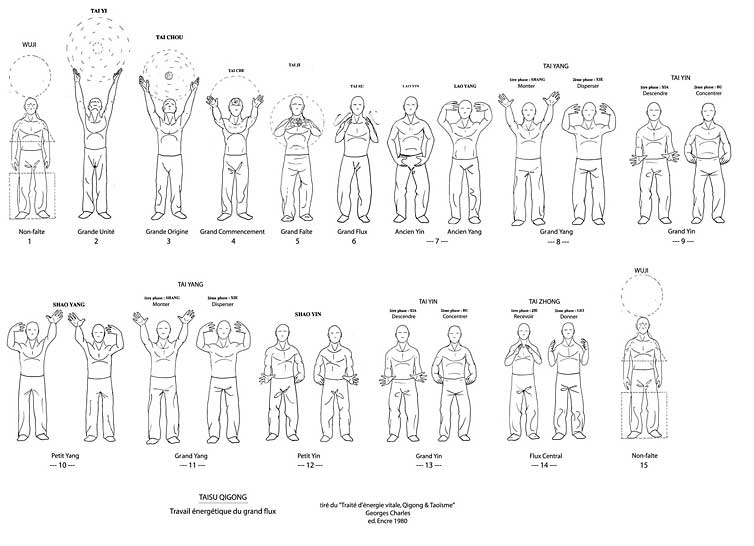YOGA TAICHI 91
Alliance harmonieuse du Taichi chuan , du Qiqong , Yoga et de la Méditation

YOGA TAICHI 91
Christian RASOTTO
1 Bd de BRETAGNE
91160 LONGJUMEAU
06 17 08 68 09
01 69 09 42 67
shanti91160@gmail.com
Le Qi Gong, qu’est-ce que c’este

In parks, on their doorsteps, or even at the factory, the Chinese millions to practice daily physical exercises that resemble gymnastics.More and more Westerners are following their example and practice Tai Chi (Tai Ji Quan) or Qi Gong (pronounced chee kung).Together, these two approaches are considered the driving energy, according to the principles of Traditional Chinese Medicine (TCM).
Qi Gong differs mainly tai chi by the prominence it gives to the control of vital energy.Indeed, the word Qi in Qigong, means the flow of energy that animates all things everywhere, and is one of the fundamental concepts of Traditional Chinese Medicine.Gong meaning work or training, Qi Gong is a practice of Qi cause, that is to say, mobilize, strengthen, increase it, to purify, balance and harmony in the circulating body and spirit.
Recall that in addition to energy drive up tai chi and Qi Gong, TCM has 4 other practices: the Chinese diet, acupuncture, Chinese medicine and Tui Na massage.Our plug Traditional Chinese Medicine gives more details about Qi and TCM in general.
.

Master Qi through the body
Regular practice of Qi Gong is intended to strengthen and relax the musculoskeletal structure of the body and to optimize the functions of the body in order to maintain health and promote longevity.In the case of diseases, it can contribute to healing.By promoting the merger, Qi Gong would also be beneficial in many areas: business, sports, artistic or educational.There are also exercises designed specifically to preserve and enhance sexual energy.
By controlling the body, breathing and thought, adherents of Qi Gong can also learn to perceive their vital energy, to focus and direct it along the paths of energy (the meridians of acupuncture).They might even come to directly absorb the Qi of the earth, sky or nature.To practice Qi Gong is used:
Movements very diverse and generally very slow, or sequences of movements.
Immobile postures, held for some time.
Stretching and undulations.
Breathing exercises, among others by the continuous recitation of meaningless sounds, like Soo Soo Ma Di Di Di Si or Wat Na Wa Wa Da Si1.
Much attention mental.
Visualization and meditation.
Note that the Qi Gong exercises are composed of shorter movements and isolated than those of tai chi.In addition, they can sometimes be performed in the supine position, while tai chi is practiced primarily in the vertical.
A thorough knowledge of traditional Chinese medicine is not essential to the practice of Qi Gong, but some concepts are useful for personal practice informed.
We can stick to consider Qi Gong as a gym, and reap many benefits, but that would miss much of its vast possibilities.Teachers of Qi Gong, for cons, must have an excellent understanding of TCM to guide practitioners to exercise appropriate to their condition.

A march towards health, not a miraculous treatment
Qi Gong is not composed of miracle could cure specific diseases specifically.But a lot of practices would enable the powerful force supporting self healing mechanisms of the individual.Thus, one class of Qi Gong can bring together people who want to keep fit, others who seek to relieve stress and others who have a particular disease.
According to its practitioners, regular practice would include the following applications:
Prevention.Promote flexibility, relaxation, relaxation, stress management, psychosomatic balance, improved vitality, disease prevention, maintenance of memory and sleep better.
Curative approach.Improving the health of people, among others, heart disease, hypertension, insomnia, ocular deficit, diabetes, paralysis, degenerative disease, deep deficit of immunity, asthma and hypercholesterolemia.
Flourishing sports.Increase quality control, endurance, breathing capacity and sudden propulsion.
Personal Development.Modulate the emotional response and adaptation to stress or emotional psycho-emotional.Foster, both in adults than in children, memory, intellectual effort, imagination and creativity.
Spiritual opening.Promote the development of certain qualities, like the calm, serenity and letting go.
Emit Qi to heal the sick
In its medical application, Qi Gong is of two kinds: one is that we practice self-form exercises (Qi Gong Sheng Yang) and one that can be applied to a patient by a practitioner (Qi Gong Waiqi).In this case, a master who has reached a very high level of expertise may not only emit Qi, but the guide specifically to a diseased organ.Stories report that such people can anesthetize patients for surgery, to repair injuries and even cure cancer.
Researchers also measured a magnetic field up to 1000 times higher than normal at the fingertips of players at the time of issuance of QI2, 3.In a study published in 20044, the authors noted that although there are still people who deny the possibility of Qi can be issued by a human, most scientists involved in this area consider it now well and truly a reality.According to them, it is clear that experienced people can make a form of bioenergy (may be called Qi) producing physical, chemical and biological measurable.For example, in a laboratory study conducted in 20095, practitioners of Qi projected on cultures of bacteria E. Coli.They need to increase or decrease, depending on their intent, the growth of bacteria compared to control samples.
More and more researchers are trying to penetrate the mysteries of scientific way of Qi6.Some have found that it could be perceived by people trained up to 100 m distance8.They even suggested what might be the wavelength of a bundle of Qi.For further details about the emitted Qi to heal, see the interview Qi Gong, an ally of modern medicineein Section More info.

From the perspective of China's energy, all healers emit Qi, whatever name one gives to their approach.The practices of healers are theoretically banned in the West, but they are more or less tolerated because considered innocuous or fanciful (as the practitioner does not even touch the patient).It is however important that healers do not encourage their patients to refuse conventional medical treatments.
A science came from the Tao
There are three main schools of Qi Gong.They have similar practices and share a common base, the Taoist concept of balance of Yin and Yang.They differ, however, by their emphasis on either side:
- Spiritual, especially the goal of freeing the mind;
- Martial, some practices, closer to the tai chi, are called shadow boxing;
- Medical

Qi and its myriad manifestations were studied in China since at least 3000 years.Persons who acquired a mastery of martial Qi would be able, it seems, to bring down an opponent without touching or having an unusual physical strength.
In China, it happens to see some masters monetize these unusual abilities at fairs...Others have developed a medical control and be able to heal seriously ill people.
After several years of prohibition of any form of Qi Gong by the Communist regime, China is today the promotion of health exercises with its people and in hospitals.
This is thanks in large part, to the Taoist monks deep knowledge of Qi was kept alive and could still be learned



